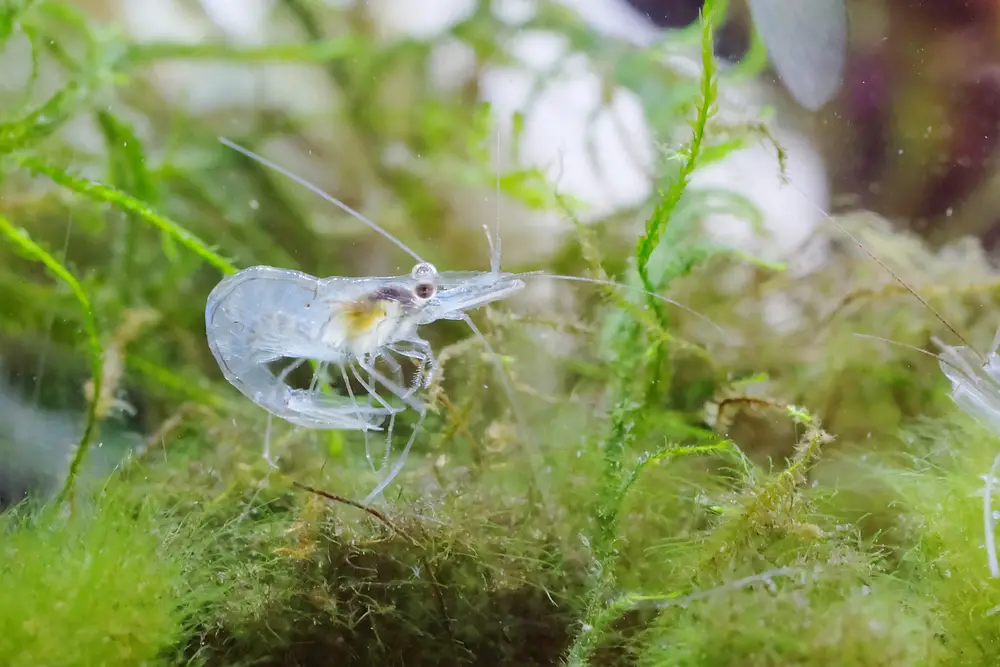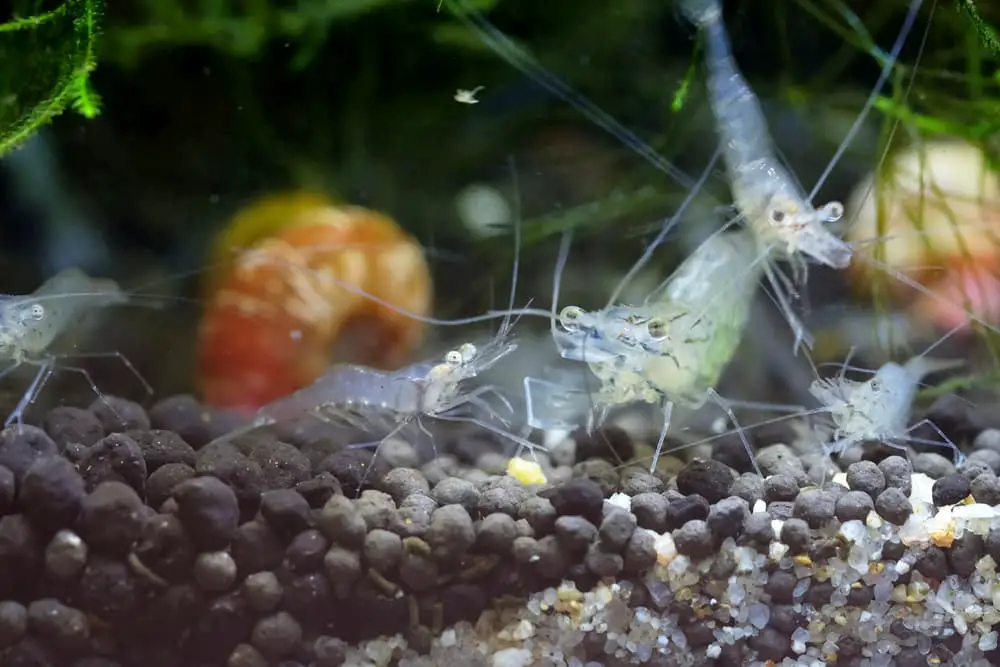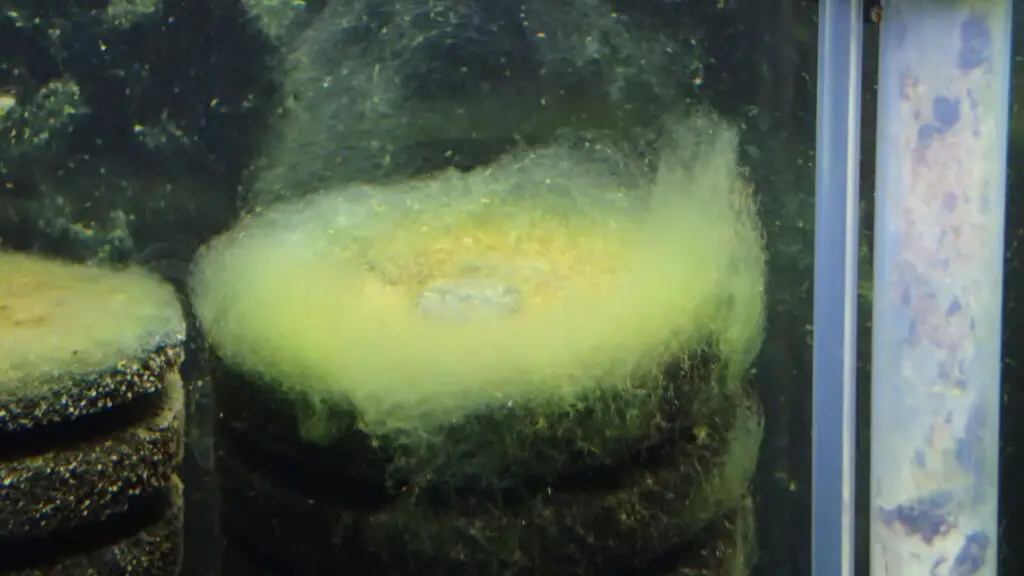 Yes, Ghost shrimp do eat algae, but their consumption is not as efficient as some other shrimp species. They are more likely to scavenge for flake
Yes, Ghost shrimp do eat algae, but their consumption is not as efficient as some other shrimp species. They are more likely to scavenge for flake food or pellets if available. However, without other food sources, they can contribute to algae control.
food or pellets if available. However, without other food sources, they can contribute to algae control.
Hello there, fellow shrimp enthusiasts! I’m here to share some of my experiences and knowledge about our translucent friend, the Ghost Shrimp. Over the years, I’ve often been asked, “Do Ghost shrimp eat algae?” The answer is yes, but it’s not as simple as it sounds. Ghost shrimp aren’t the most efficient algae eaters out there, but they do contribute to algae control uniquely.
Dietary Habits of Ghost Shrimp
Ghost shrimp, also known as glass shrimp, are fascinating creatures with a diverse diet. They are omnivorous scavengers, meaning they eat a variety of food, including plant matter, detritus, and small aquatic animals. This diet makes them excellent cleaners for your aquarium, as they help to break down and consume organic matter that would otherwise accumulate in the tank.
One of the primary components of a ghost shrimp’s diet is detritus, which includes dead plant material, uneaten food, and even dead animals. They are often seen digging through the substrate of the tank, searching for these tasty morsels. This scavenging behavior is beneficial for the tank’s ecosystem, as it helps to recycle nutrients and reduce waste.
In addition to detritus, ghost shrimp also consume algae. They use their small, claw-like appendages to scrape algae off surfaces and into their mouths. However, it’s important to note that while ghost shrimp do eat algae, they are not the most efficient algae eaters. Their consumption of algae is often incidental and secondary to their preference for other food sources.
Ghost shrimp are also known to eat small aquatic animals, such as brine shrimp, daphnia, and even other smaller shrimp. They are opportunistic feeders, meaning they will eat whatever is available to them. However, they are not aggressive hunters and typically only consume other animals if they are already dead or dying.
In a well-balanced aquarium, ghost shrimp can find plenty of food naturally. However, if the tank is very clean or if the ghost shrimp population is high, supplemental feeding may be necessary. Flake food, algae wafers, and even blanched vegetables can be good food sources for ghost shrimp.
Ghost Shrimp and Algae: An Incidental Relationship
When it comes to the relationship between ghost shrimp and algae, it’s best described as incidental. Ghost shrimp are not specialized algae eaters like some other aquatic creatures, but they do consume algae as part of their varied diet.
Ghost shrimp are omnivorous scavengers, meaning they eat a wide range of food, including plant matter, detritus, and small aquatic animals. Algae, being a type of plant matter, naturally falls into their diet. However, their consumption of algae is not a primary dietary focus, but rather a byproduct of their scavenging behavior.
In their quest for food, ghost shrimp will often scrape off and consume algae that they come across on the surfaces of the tank, including the substrate, decorations, and even the tank walls. They use their small, claw-like appendages to scrape off the algae and bring it to their mouths. This incidental consumption of algae can contribute to algae control in the tank, but it’s not their main food source.
Ghost shrimp are more likely to consume algae when other food sources are scarce. If there’s plenty of detritus or other food available, they will often prefer that over algae. However, in the absence of other food, they can and will turn to algae for sustenance.
It’s also worth noting that while ghost shrimp do consume algae, they are not the most efficient at it. Their small size and the incidental nature of their algae consumption mean they are not as effective at controlling algae as some other creatures, such as certain species of snails or specialized algae-eating shrimp.

Comparing Ghost Shrimp and Other Algae-Eating Shrimp Species
When it comes to algae-eating prowess, not all shrimp are created equal. While ghost shrimp do consume algae as part of their varied diet, they are not the most efficient algae eaters in the shrimp world. Let’s compare ghost shrimp with some other shrimp species known for their algae-eating abilities.
Ghost Shrimp: As we’ve discussed, ghost shrimp are omnivorous scavengers that consume a wide range of food, including algae. However, their consumption of algae is incidental and not their primary focus. They are more likely to consume algae when other food sources are scarce. Ghost shrimp are excellent cleaners for your aquarium due to their diverse diet, but if your primary goal is algae control, they may not be the most effective choice.
Amano Shrimp: Named after the famous aquarist Takashi Amano, Amano shrimp are renowned for their algae-eating abilities. They are particularly good at consuming hair algae and other types of soft algae that many other creatures won’t touch. Amano shrimp are larger and more aggressive eaters than ghost shrimp, making them more effective at controlling algae.
Cherry Shrimp: Cherry shrimp are another popular choice for aquariums, known for their bright red coloration. Like ghost shrimp, they are omnivorous and will consume algae as part of their diet. However, they are generally more efficient at eating algae than ghost shrimp, especially when it comes to certain types of soft algae.
Bamboo Shrimp: Bamboo shrimp, also known as wood shrimp, are filter feeders. They use their fan-like appendages to filter out tiny particles from the water, including microscopic algae. While they won’t scrape algae off surfaces like ghost, Amano, or cherry shrimp, they can help control the levels of free-floating algae in the water.

The Role of Ghost Shrimp in Algae Control
Ghost shrimp, with their omnivorous diet and scavenging behavior, can play a role in algae control within an aquarium. However, it’s important to understand the extent and limitations of their contribution to managing algae levels.
As scavengers, ghost shrimp consume a wide variety of food, including algae. They use their small, claw-like appendages to scrape off algae from various surfaces in the tank. This can help to reduce the amount of algae in the tank, particularly in areas that are hard to reach or clean manually.
However, ghost shrimp are not specialized algae eaters. Their consumption of algae is incidental and secondary to their preference for other food sources, such as detritus and small aquatic animals. This means that while they do consume algae, they are not as efficient at controlling algae as some other creatures.
Ghost shrimp are more likely to consume algae when other food sources are scarce. If there’s plenty of detritus or other food available, they will often prefer that over algae. However, in the absence of other food, they can and will turn to algae for sustenance.
It’s also worth noting that the size and number of ghost shrimp in your tank can affect their impact on algae control. A single ghost shrimp in a large tank will have a minimal effect on algae levels. On the other hand, a large number of ghost shrimp in a small tank can have a noticeable impact on algae control, especially if other food sources are limited.
Ghost shrimp can contribute to algae control in an aquarium, they are not the most effective solution if algae control is your primary goal. They are part of a balanced aquarium ecosystem and can help to reduce waste and recycle nutrients, but for significant algae problems, other solutions may be more effective.

Factors Influencing Algae Consumption by Ghost Shrimp
The consumption of algae by ghost shrimp is influenced by several factors. Understanding these factors can help you manage your aquarium more effectively and ensure the health and happiness of your ghost shrimp. Let’s delve into some of the key factors that influence algae consumption by ghost shrimp.
1. Availability of Other Food Sources: Ghost shrimp are opportunistic feeders, meaning they will eat whatever is available to them. If there’s plenty of detritus or other food available, they will often prefer that over algae. However, in the absence of other food, they can and will turn to algae for sustenance.
2. Algae Type: Not all algae are created equal, and some types are more palatable to ghost shrimp than others. Ghost shrimp are more likely to consume soft, green algae than harder, tougher types of algae. If your tank is primarily infested with a type of algae that ghost shrimp don’t prefer, they may not contribute much to algae control.
3. Tank Conditions: The conditions in your tank can also influence algae consumption by ghost shrimp. Factors such as temperature, pH, and water hardness can affect the health and behavior of ghost shrimp, including their feeding habits. If the tank conditions are not optimal, ghost shrimp may be less active and eat less, including algae.
4. Ghost Shrimp Population: The number of ghost shrimp in your tank can also affect their impact on algae control. A single ghost shrimp in a large tank will have a minimal effect on algae levels. On the other hand, a large number of ghost shrimp in a small tank can have a noticeable impact on algae control, especially if other food sources are limited.
5. Competition: If there are other algae-eating creatures in the tank, such as other species of shrimp or certain types of fish or snails, they may outcompete ghost shrimp for algae. Ghost shrimp are not the most aggressive or efficient algae eaters, so they may lose out in competition with other creatures.
While ghost shrimp do consume algae, their consumption is influenced by a variety of factors. Understanding these factors can help you manage your aquarium more effectively and ensure the health and happiness of your ghost shrimp.

The Impact of Food Availability on Ghost Shrimp’s Algae Eating Habits
Food availability plays a significant role in shaping the algae eating habits of ghost shrimp. As opportunistic feeders, ghost shrimp are flexible in their diet and will consume what’s readily available in their environment. Let’s explore how the availability of food can impact their algae eating habits.
Ghost shrimp are omnivorous scavengers, meaning they eat a wide range of food, including plant matter, detritus, and small aquatic animals. Algae, being a type of plant matter, naturally falls into their diet. However, their consumption of algae is not a primary dietary focus, but rather a byproduct of their scavenging behavior.
In a well-stocked aquarium, ghost shrimp can find plenty of food naturally. Detritus, which includes dead plant material, uneaten food, and even dead animals, is a primary food source for ghost shrimp. They are often seen digging through the substrate of the tank, searching for these tasty morsels. This scavenging behavior is beneficial for the tank’s ecosystem, as it helps to recycle nutrients and reduce waste.
When there’s plenty of detritus or other food available, ghost shrimp will often prefer that over algae. They are more likely to consume algae when other food sources are scarce. If the tank is very clean or if the ghost shrimp population is high, supplemental feeding may be necessary. In such cases, ghost shrimp may turn to algae for sustenance.
However, it’s important to note that while ghost shrimp do eat algae, they are not the most efficient algae eaters. Their small size and the incidental nature of their algae consumption mean they are not as effective at controlling algae as some other creatures.
The availability of food in the aquarium significantly impacts the algae eating habits of ghost shrimp. They are opportunistic feeders that consume a variety of foods, making them excellent cleaners for your aquarium. However, if your primary goal is algae control, other species of shrimp may be more effective.

Practical Tips for Using Ghost Shrimp in Algae Control
While ghost shrimp are not the most efficient algae eaters, they can still play a role in algae control within an aquarium. Here are some practical tips for using ghost shrimp in algae control:
1. Maintain a Balanced Ghost Shrimp Population: The number of ghost shrimp in your tank can affect their impact on algae control. A single ghost shrimp in a large tank will have a minimal effect on algae levels. On the other hand, a large number of ghost shrimp in a small tank can have a noticeable impact on algae control, especially if other food sources are limited.
2. Ensure a Variety of Food Sources: Ghost shrimp are omnivorous scavengers that consume a wide range of food, including algae. However, they prefer other food sources over algae. To encourage ghost shrimp to consume algae, make sure there are not too many other food sources available. This doesn’t mean you should starve your ghost shrimp, but rather control the amount of food you add to the tank.
3. Use Ghost Shrimp as Part of a Clean-Up Crew: Ghost shrimp can be part of a team of algae-eating creatures in your tank. Other species of shrimp, certain types of snails, and even some fish species are known for their algae-eating abilities. A diverse clean-up crew can be more effective at controlling algae than ghost shrimp alone.
4. Monitor Tank Conditions: The conditions in your tank can affect the health and behavior of ghost shrimp, including their feeding habits. Regularly check the temperature, pH, and water hardness to ensure they are within the optimal range for ghost shrimp.
5. Consider the Type of Algae: Ghost shrimp are more likely to consume soft, green algae than harder, tougher types of algae. If your tank is primarily infested with a type of algae that ghost shrimp don’t prefer, they may not contribute much to algae control.
Conclusion
In the world of aquariums, ghost shrimp are versatile creatures that can contribute to algae control, albeit not as efficiently as some other species. Their algae-eating habits are influenced by a variety of factors, including the availability of other food sources, the type of algae present, and the overall conditions within the tank.
While they may not be the first choice for serious algae problems, ghost shrimp can still play a valuable role in maintaining the balance of your aquarium ecosystem. They are excellent scavengers that help reduce waste and recycle nutrients, making them a beneficial addition to any tank.
Remember, every aquarium is unique, and what works best will depend on your specific situation. Don’t be afraid to experiment and observe to find the best balance for your tank.
If you need any further help understanding the role of ghost shrimp in algae control or have any other questions about shrimp keeping, please don’t hesitate to reach out.
Happy Ghost Shrimp Keeping!
Frequently Asked Questions About Ghost Shrimp
Q. Are ghost shrimp good for your tank?
A. Yes, ghost shrimp are beneficial for your tank. They are excellent scavengers that help reduce waste and recycle nutrients, contributing to the overall health of the aquarium ecosystem.
Q. Are ghost shrimp easy to keep alive?
A. Ghost shrimp are generally easy to keep alive as long as their basic needs are met. They require clean water with the right parameters (temperature, pH, hardness), a good diet, and a safe environment free from aggressive tank mates.
Q. What is the purpose of ghost shrimp?
A. Ghost shrimp serve several purposes in an aquarium. They are excellent scavengers, helping to keep the tank clean by consuming detritus and algae. They also add interest to the tank with their unique transparent appearance and active behavior.
Q. Are ghost shrimp aggressive?
A. Ghost shrimp are generally peaceful creatures. However, they can become aggressive if food is scarce or if they are kept in overcrowded conditions. It’s also worth noting that they can sometimes prey on smaller or weaker creatures, especially in a food-limited environment.
Q. Do ghost shrimp clean fish waste?
A. Ghost shrimp can help break down fish waste by consuming it. However, they should not be relied upon as the sole means of waste management in an aquarium. Regular water changes and a good filtration system are also crucial for maintaining water quality.
Q. Do ghost shrimp eat other fish?
A. Ghost shrimp are not typically predatory towards fish. However, they are opportunistic feeders and may eat dead or dying fish. They are unlikely to harm healthy fish.
Q. Do ghost shrimp need land?
A. No, ghost shrimp are fully aquatic and do not need land. They spend most of their time on the bottom of the tank, scavenging for food.
Q. Can ghost shrimp live in tap water ?
?
A. Ghost shrimp can live in tap water, but the water needs to be treated with a dechlorinator first, as chlorine and chloramines found in tap water can be harmful to them. It’s also important to ensure that the water parameters (temperature, pH, hardness) are within the suitable range for ghost shrimp.
first, as chlorine and chloramines found in tap water can be harmful to them. It’s also important to ensure that the water parameters (temperature, pH, hardness) are within the suitable range for ghost shrimp.
